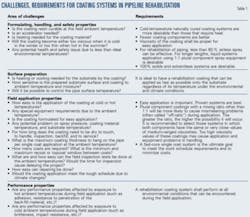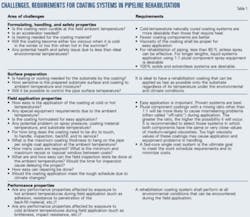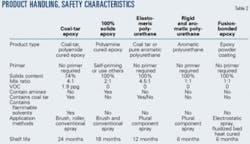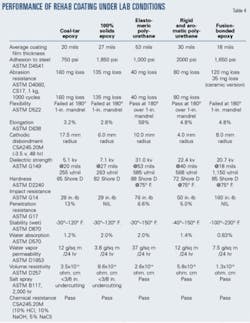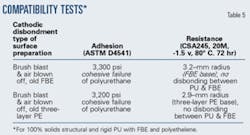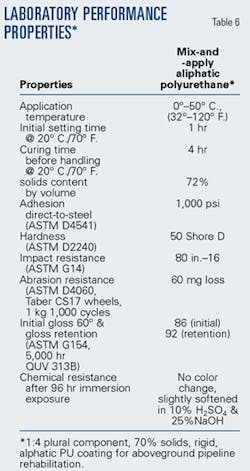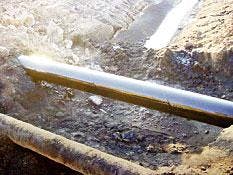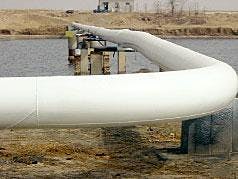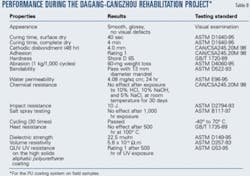An advanced 100% solids structural and rigid polyurethane coating was employed in rehabilitating the Dagang-Cangzhou gas pipeline in northeastern China.
Outlined here are the challenges and requirements for such a system and the performance testing results achieved during this project on both laboratory and field prepared samples.
Corrosion extent
Corrosion is the primary factor affecting the longevity and reliability of pipelines throughout the world. In the US, there are more than 328,000 miles of natural gas transmission and gathering pipelines, 74,000 miles of crude transmission and gathering pipelines, and 82,000 miles of hazardous liquid transmission pipelines. Estimates of the corrosion-related cost to the US gas and liquid transmission pipeline industry range from $5.4 to $8.6 billion/year. Corrosion-related costs of operation and maintenance make up 80% of this cost.1
A recent survey of major US pipeline companies found that the primary cause of loss of corrosion protection was coating deterioration (30%) and inadequate cathodic-protection current (20%).2 With 30% of the operational pipeline corrosion problems attributed to coating deterioration, a large portion of the corrosion control budget covers monitoring, identifying, and repairing coating anomalies.
Since 1999, China has built about 12,500 miles of long-distance transmission pipelines and 155,500 miles of gathering pipelines; most of the coatings on these buried pipelines have aged so severely that the lines are exposed to corrosive underground environments.
The desire to extend a pipeline's operating life and reduce its life cycle costs has led to the emergence of coating rehabilitation as a means of pipeline corrosion control.
The need to be able to apply coatings at all environmental temperatures, particularly in cold winters, has challenged pipeline rehabilitation. Applying coatings in the field in cold weather raises issues of coating properties, surface preparation, and inspection. This challenge puts various requirements on a pipeline rehabilitation coating system in terms of coating formulating properties including environmental and safety issues, surface preparation, field-application properties, performance and overall cost.
Over the years, many field-applied coating systems have been developed for pipeline rehabilitation in China. These systems include field-applied single or dual-layer fusion-bonded epoxies, liquid-applied coal-tar or non-coal tar epoxies (either solvent-based or 100% solids), elastomeric polyurethanes, cold-applied or hot-applied tapes, cement materials, and wax and composite systems. None of these coatings provides a good solution for all temperature field applications.
As a result, the Chinese oil and gas pipeline industry for some time has searched for a coating system that can provide not only high performance for oil and gas field pipeline rehabilitation but also can be applied during winter in Northern China.
One of the main pipelines that supply natural gas to northeastern Chinese cities is the 62 mile, 21-in. OD DaGang-CangZhou line installed in 1973 and originally protected by a petroleum-asphalt enamel coating. Since then the pipeline has experienced severe corrosion problems, which were not resolved even after numerous localized rehabilitation applications.
In 2001, operator PetroChina Dagang Oilfield Natural Gas Co. decided to refurbish the pipeline completely. A 100% solids, rigid and structural aromatic PU coating was selected for a river crossing and some underground and aboveground portions.
In November 2001, PetroChina Dagang Oilfield formed a special technical committee officially to appraise the rehabilitation project based on both testing and field performance. Details of the committee's findings, although publicly available, form the basis of this article.
Design, selection
For years, the pipeline industry has required an effective rehabilitation coating system with excellent application and performance properties and the ability to withstand corrosive environments. To meet these requirements, a pipe rehabilitation coating system must be able to meet the challenges of environmental and safety regulations, economics, field application conditions, effectiveness, and high performance.
Engineers must strike a balance between these five areas. The ideal pipeline rehabilitation coating system must be environmentally friendly, worker-safe, durable, and able to expose little or no metal or substrate surface to the environment. It must also resist environmental, mechanical, and chemical damage during application, handling, burial, or insulation. It should be capable of being applied efficiently and effectively under restricted environmental and work conditions in the field. Finally, it should come at a reasonable cost.
As a result of these requirements, design and selection of a pipeline rehabilitation coating system should be based on careful considerations of the following parameters:
- Handling, safety characteristics. These characteristics include mixing ratio, solids content, volatile organic compounds, flammability, application methods, as well as whether the coating contains any hazardous ingredients such as coal tar, amines, solvents or VOCs, and isocyanate monomers.
- Field application, repair attributes. These attributes determine the construction contractor's ability to achieve the proper results for pipeline rehabilitation. The quality of field application is limited by the number of coats, curing temperature, and cure time required by the coating materials.
The coating system should also be able to be applied under a wide variety of specific field and environmental conditions such as humidity, wind, rain, ambient temperatures, dewpoint, space limitation, location, etc.
If the pipeline is in service during the rehabilitation, any heating or cooling necessary for good coating application is severely limited because product flow temperature will overpower any localized attempt at heating or cooling. Because ambient conditions are difficult to control, rehabilitation coating should be ready to apply and handle as soon as possible.
- Surface-preparation requirements. Surface preparation is essential to the ability of the coating to bond to the pipe substrate and the existing coating. This bonding is important to eliminate environmental fluid migration between the substrate and the pipe coating. It also ensures permanence and the ability to withstand handling, burial, or insulation without losing effectiveness.
Surface preparation often becomes a bottleneck for pipeline rehabilitation. Abrasive blasting to an often recommended SSPC-SP10 (NACE 2) near-white or SSPC-SP5 (NACE No.1) white-metal surface can be slow.
It is also important to ensure the compatibility of the field-applied coating with the plant-applied mainline coating. Surface preparation often requires special procedures at transitions between the existing coating and the rehabilitation coating such as feathering the abrasive blasting edge for several inches into the existing coating to improve adhesion.
The extent of surface preparation for the transitions depends on how compatible the rehabilitation coating is with the existing coating. The choice of a type of blasting machinery to use for surface preparation during a pipeline rehabilitation project is related to the total length of the pipeline, production daily rate, and whether the pipeline can be taken out of service and cut into long sections.
- Physical performance requirements. Performance of a pipeline rehabilitation coating depends on such factors as the adhesion to the pipe substrate and the existing coating, abrasion, impact, and penetration resistance (hardness), chemical and corrosion resistance, dielectric strength and cathodic disbondment resistance, flexibility or bendability, stability at low or elevated temperature service conditions, and water absorption or water vapor permeability. Details of the requirements of these performance properties can be found elsewhere.4
- Case histories. Many coating manufacturers are in a rush to develop and launch new pipe rehabilitation coating systems. An example is 100% solids polyurea coating. While the industry should appreciate the variable choices of rehabilitation coatings and coating suppliers, it is very important to select those coating technologies, products, and coating suppliers that are backed by solid case histories for both performance and technical support.
- Cost analysis. The true cost of any rehabilitation coating system is not the "cost per bucket" or even the initial applied cost ($/sq feet or $/sq m). The true coating cost = materials cost + application cost + maintenance cost + "hidden" cost. This true cost should cover the initial costs of the coating material and its field-application, handling and burial, throughout the entire operation period.
Dealing with costs cannot avoid maintenance costs and hidden costs. To reduce the total life cycle cost of a pipeline, it is also desirable to reduce the rehabilitation and repair to a one-time event or to reduce the maintenance cost of the rehabilitation coating.
Maintenance costs of a field-applied rehabilitation coating project are related to the performance of the coating. High-performance coatings, although normally having higher initial material costs, often provide the advantage of lower maintenance costs.
An example of "hidden" costs is the one due to project delay; hence the high production rate of a field-applied coating is important. The ability to bring the pipeline back into service almost immediately can mean significant economic and other benefits.
The challenge of field-applying coatings for pipeline rehabilitation at all environmental temperatures, particularly in cold winters, implies additional requirements on the rehabilitation coating systems in terms of coating formulating properties including handling and safety characteristics, surface preparation, field-application flexibility and properties, performance and cost.
Table 1 outlines these requirements.
Rigid PU technology
From the very first years that polyurethanes were introduced to the pipeline market, most engineers recognized the capability of the versatile PU chemistry to meet the challenges outlined above to establish a good field-applied coating technology for pipeline rehabilitation. While there are many types of PU coatings available and already utilized in various conditions, today's PU coatings for pipeline applications refer only to the materials that are 100% solids and defined by ASTM D16 as Type V, two-package, liquid, polyisocyanate, polyol cured, urethane.5
This coatings technology has received attention from the pipeline industry for many reasons.
First, 100% solids polyurethanes have excellent handling and safety attributes. They are safer and more environmentally friendly than traditional anti-corrosion coatings. They contain no solvents, VOCs, styrene, amine, tar, or other carcinogens. They are generally not affected by scrutiny from the US Environmental Protection Agency, Occupational Safety and Health Administration and the Department of Transportation scrutiny over the health and safety hazards associated with other polymer systems.
Secondly, because of the rapid curing speed of these coatings, the coated pipe section and joints can be holiday tested and buried within hours.
Thirdly, many 100% solids polyurethanes have a cold-temperature-curing ability, making it possible to apply the coating at ambient temperatures as low as –40° C. and retain their performance characteristics, which is impossible for other types of coatings.
Finally, no heat is required during application to ensure the polyurethanes will cure, and the coatings can be applied to almost any thickness on any diameter or length of pipe.
Most field-applied PU coatings used for pipeline rehabilitation applications, however, have been traditionally based on 100% solids elastomeric PU chemistry, with or without coal tar or petroleum tar.
The major advantages of 100% solids elastomeric PU coatings are their flexibility and elongation properties, impact resistance, and abrasion resistance. The major disadvantages are that they are relatively low in alkali and solvent-resistance, low in adhesion to substrate or existing plant-applied pipeline coatings, low in cathodic disbondment resistance, low in dielectric strength, low in high-temperature resistance, but high in moisture and water absorption and permeability.
In addition to these performance issues, many elastomeric PU coatings used in pipeline rehabilitation often come with a high mixing ratio (4.5:1, for example) as well as unbalanced high viscosity of the components.
These formulating weaknesses make the coatings difficult to apply and many coating film defects are associated with application error.
The past 10 years have seen a movement in North America towards development and use of high-performance 100% solids rigid (or structural) PU coatings for corrosion protection of all three pipe substrates: steel, ductile iron, and concrete.
Differing from the linear polymeric structures of a 100% solids elastomeric PU or polyurea system, a 100% solids rigid PU forms a three-dimensional, cross-linked structure, thus providing the coating film with superior resistance to chemicals, water penetration, cathodic disbondment, and temperature extremes.
The finished product is structural in nature because it forms a strong polymeric solid film, similar in feel and appearance to the casing on a laptop computer, and has structural rigidity.
In North America, 100% solids rigid PU coatings were first developed in the early 1970s specifically for underground storage tanks. In 1975, Underwriters Laboratories of Canada issued the first listing for cathodically protected steel tanks with a rigid PU coating system. In 1981, the same technology was approved for use in the STI-P3 tank by the Steel Tank Institute.
By the late 1980s, 100% solids rigid or structural PU technology had almost completely replaced coal-tar epoxy and other coatings technologies in the North American underground storage tank industry. By January of 1998, STI reported that more than 250,000 STI-P3 underground steel fuel storage tanks had been registered and installed in the US.
In addition, STI of Canada estimated that 100,000 steel tanks had been installed in Canada. In total, these tanks involved approximately 200 million sq ft of steel and more than 80% of the area was coated with 100% solids rigid PU coatings. The technology's performance has been nearly flawless, according to a 1993 report by a US-based risk-management consulting firm.6
A tank can be viewed as a pipe with two closed ends. If such an underground tank could be installed to eliminate corrosion, why not coat an underground pipe with that very same coatings technology?
This idea has resulted in the use of the 100% solids rigid coatings in pipelines. In water and wastewater transmission pipeline applications, the 100% solids structural PU coatings have been demonstrated to be by far the most successful protective coating systems used for both exterior and interior applications.7
AWWA C222 describes the material and application requirements of 100% solids rigid PU coatings for the interior and exterior of steel water pipe, fittings, and special sections.8 Currently, NACE Task Group (TG) 281, administered by NACE Specific Technology Group 03, is developing a NACE standard recommended practice for the use of PU coatings for field repair, rehabilitation, and girth weld joints on pipelines. This standard applies to underground steel pipelines in the oil and gas gathering, distribution, and transmission industries.
Partnership
Since 1998, PetroChina Tianjin Dagang Oilfield and Madison Chemical Industries Inc., Canada, have joined to develop advanced pipeline rehabilitation coatings for the Chinese oil and gas pipeline industry, based on the 100% solids rigid and structural PU chemistry.
One of the projects is to develop and utilize a sprayable, aromatic 100% solids rigid and structural PU coating for the Chinese oil and gas pipeline industry to resolve its long-term search for a coating system that can not only provide high performance for field oil and gas pipeline rehabilitation but also be applied during winter in Northern China.
The sprayable, aromatic PU resin version involves various formulations that have a 1:1 mixing ratio with balanced viscosities between the two reactive components: Part A–polyisocyanate rich component and Part B–polyol rich component.
Relatively lower viscosity (70–1,000 cps at 70° F.) of both the components can be obtained by a skilled formulator. This enables easier metering of the components, requiring less in-line heating and offering better atomization for spray. Special setting times are often made in order to meet the manual spray application needs in-field as well as the need for faster back to service times.
The plural component material is transferred from the containers to a plural component airless pump, heated as it moves through the in-line heaters, and then applied with a plural component spray gun or, for slower setting formulations, through a whip hose and then the gun. The gun and hoses are held by the sprayer and the coating is applied to the required thickness in a one coat multi-pass operation.
Depending on its setting-time design and pipe-surface temperature, the coating material can set up over the ditch within minutes. The pipeline can be holiday tested and brought back into service within hours.
Table 2 highlights the product handling and safety characteristics of the 100% solids rigid sprayable, aromatic PU resin version, together with some other typical liquid-applied field coatings that are used today in the market for pipeline rehabilitation. Examples of these typical coatings include a coal-tar epoxy, a 100% solids epoxy, and a 100% solids elastomeric, aromatic PU, and an FBE coating.
As to the field rehabilitation application, both 100% solids elastomeric PU and 100% solids rigid PU have their own limitations.
First, the economics of applying the spray-applied coating must be favorable to substantiate the cost of transporting and operating a plural-component spray system to the site. Secondly, since the polyurethanes are a liquid spray system, precautions must be taken in heavily traveled and built up areas to ensure that buildings are not hit by overspray or people are not exposed to any health risk. This, of course, is true for all the spray-applied coatings systems including liquid epoxies.
Finally, again due to the use of a plural-component spray system, the spray application process can be very sophisticated, and therefore the coating personnel must be experienced and trained to ensure that the proper procedures are being followed at all times.
Table 3 outlines the field application and repair attributes of the 100% solids, rigid, aromatic PU technology, compared with other rehabilitation coating systems.
Performance properties of the advanced 100% solids rigid sprayable, rigid, aromatic PU resin version were determined in-house and through independent laboratories on samples prepared under laboratory conditions.9-12 Tests were conducted on pipe samples on which the coatings had been applied over surfaces prepared according to manufacturers' specifications.
Test results of these performance properties were obtained and compiled with the results of tests performed by independent laboratories on other coatings systems. Table 4 lists the typical testing results of these performance properties.
The test results shown in Table 4 suggest that the 100% solids rigid, aromatic PU coatings outperform liquid-applied epoxies and the 100% solids elastomeric PU, with properties comparable to those of the typical FBE system.
Additional tests evaluated the compatibility of the 100% solids rigid, aromatic PU system with various pipe samples coated with the plant-applied mainline FBE or polyethylene. Two sets of samples were produced.
The testing set of samples was made by spraying the 100% solids rigid, aromatic PU coating onto a 2 month-old FBE and three-layer PU-coated pipe section. A brush blast was employed. Adhesion tests (ASTM D4541) and cathodic-disbondment tests (CSA245.20M, -1.5 v, 80° C., 72 hr) were then conducted on the multi-coated samples, with results shown in Table 5.
For aboveground application, high solids or 100% solids, aliphatic PU coatings technologies were also developed in order to provide UV stability. An example is a 1:4 plural component, mix-and-apply, 70 % solids, fast chemically-cure, UV and color stable, direct-to-metal, aliphatic PU.
The mix-and-apply PU is applied with a single component spray gun. Because it involves premixing two ingredients before application, the per-coat film build is higher. The pot life of the PU is about 2 hr, and the coating has an initial cure time of about 1 hr
A 1:1 plural component, 100% solids, aliphatic PU has also been developed and is under field testing for pipeline rehabilitation applications. Table 6 outlines some properties of the 1:4 plural component, mix-and-apply, high solids, direct-to-metal, aliphatic PU.
Dagang-Cangzhou rehab
One of the main pipelines that supply natural gas to northeastern Chinese cities is the 62-mile, 21-in. OD Dagang-Cangzhou gas pipeline, installed in 1973 and originally protected by a petroleum asphalt enamel coating.
Since installation, the pipeline has faced severe corrosion problems, despite numerous rehabilitation efforts. In 2001, PetroChina Dagang Oilfield Natural Gas Co. decided to refurbish the entire pipeline. A 100% solids, rigid and structural aromatic PU coating technology was selected for a river crossing and some underground and aboveground portions.
For the river crossing and aboveground pipe segments, a thin film (3-5 mils, or 75-125 (m) of a 1:4 mixing ratio, high solids, aliphatic PU, was applied over the 100% solids aromatic PU coating for protection against UV light. The total application coating film thickness ranged from 35 to 40 mils (850 to 1,000 (m).
Application of the Madison's PU coating took place between November 2001 and May 2002, with field application temperature ranging from 5° F. to 86° F. (-15° C. to 30° C.). Extensive tests on lab and field samples were then conducted. In November 2001, PetroChina Dagang Oilfield formed a special technical committee and officially appraised the rehabilitation project based on both testing results and field performance (Figs. 1, 2, and 3).
null
null
null
Before the coating application, the pipe section to be coated was surface cleaned to remove contaminations such as oil and dirt and then abrasive blasted with medium grade coal slag abrasives to a near-white metal blasting (SSPC-SP 10 / Sa 2.5) with a surface profile of 40-60 (m). Coating application was done within 4 hr of blasting.
The field inspection included two elements: in situ adhesion and holiday inspection and field sample preparation for third-party lab testing. At -15° C., the field-applied coating cured in about 5 min. Adhesion and holiday testing occurred within 60 min of the coating application and revealed that at that time the coating breakdown testing voltage already reached 12 kv (more than 342 v/mil). The field-coated samples were packed and sealed on site then sent immediately to the Pipeline Coating Testing Centre of the Research Institute of Engineering Technology of China National Petroleum Corp.
Tables 7 and 8 show typical field inspection results of the rehabilitation using the PU coatings at cold and hot ambient temperatures.
Table 9 shows results of testing on the field samples.
Results of both field inspection and lab evaluation showed that the properties of the 100% solids rigid PU coating outperformed all liquid-applied epoxy systems used in China and exceeded or matched the performance of fusion bonded epoxy coating.
References
1. Koch, Gerhardus H., Brongers, Michiel P.H., Thompson, Neil G., Virmani, Y. Paul, and Payer, Joe H., "Corrosion Costs and Preventive Strategies in the United States, Appendix E, Gas and Liquid Transmission Pipeline," report by CC Technologies Laboratories Inc. to Federal Highway Administration, Office of Infrastructure Research and Development, Report FHWA-RD-01-156, September 2001.
2. "Best Practices Benchmarking Study," Independent Survey of Pipeline Companies, October 1999, by CC Technologies, Dublin, Ohio; contact: [email protected].
3. Zhang, L.P., Lin, Z., and Zhang, Q., "Research and Application of External Rehabilitation Material for Buried Pipeline," proceedings of the Second China International Corrosion Control Conference (CICC'2002), Beijing, November 2002.
4. Guan, S., "Advanced 100% Solids Rigid Polyurethane Coatings Technology for Pipeline Field Joints and Rehabilitation," presented to NACE International Corrosion 2003, San Diego, March 2003.
5. ASTM, "Standard Terminology for Paint, Related Coatings, Materials, and Applications," D16-00.
6. Geyer, W., "Handbook of Storage Tank Systems Available Now," New York: Marcel Dekker Inc., 2000.
7. Guan, S., "Corrosion Protection By Coatings for Water and Wastewater Pipeline," Appalachian Underground Corrosion Short Course, Water and Wastewater Program, West Virginia University, WV, May 15, 2001.
8. AWWA C222-99, "Polyurethane Coatings for the Interior and Exterior of Steel Pipelines and Fittings," Denver: AWWA, 1999.
9. China Dagang Oil Field Committee of Science and Technology, "A Report on Natural Gas Pipeline Rehabilitation Coatings and Applications," internal report, July 2002.
10. "A Testing Program for External Pipeline Rehabilitation Coatings," AMEC SPIE Group Co. Houston, internal report, 1992.
11. "Laboratory Testing Program: Performance Evaluation of Madison Chemical Industries Black CorroPipe P.W.," ITI-Anti-Corrosion Inc., Houston, 1992, internal report.
12. "Laboratory Testing Program: Performance Evaluation of Madison Chemical Industries CorroClad 2000," ITI-Anti-Corrosion Inc., 1992
The authors
Shiwei William Guan ([email protected]) is vice-president for R&D and international businessat Madison Chemical Industries Inc., Milton, Ont. He holds a PhD in material science and engineering (corrosion; 1993) from McMaster University Hamilton, Ont. He is a member of NACE International, SSPC, ASTM, and the Toronto Society for Coatings Technology.
Zunyi Li is former deputy general manager of PetroChina Tianjin Dagang Oilfield with an academic rank of senior engineer at a full-professor level.
Huaiyi Liu ([email protected]) is former general manager at PetroChina Tianjin Dagang Oilfield Natural Gas Co. He graduated (1969) from Beijing Petroleum University in China. He holds the academic rank of senior engineer at a full-professor level and is a member of the Chinese Natural Gas Standard & Technology Committee.
Yaming Chen ([email protected]) is general manager at Puhai Chemical Ltd. of PetroChina Tianjin Oilfield. He holds an MBA (2001) from Tianjin Finance and Economics University, China.
Guanglu Xie ([email protected]) is a director at PetroChina Tianjin Dagang Oilfield Natural Gas Co. He holds a BEng (1984) from Tianjin University, China, and an academic rank of senior engineer.
Guozhou Zhang ([email protected]) is polyurethane business manager at Puhai Chemical Ltd. of PetroChina Tianjin Oilfield. He holds a BEng (1986) from Tianjin University in China and an academic rank of senior engineer in pipeline corrosion protection. He is a member of the specialty committee of corrosion of China Petroleum Association.
Coated and uncoated pipe are compared after 5 min of polyurethane coating application at –15° C. (9° F.; Fig. 1).
